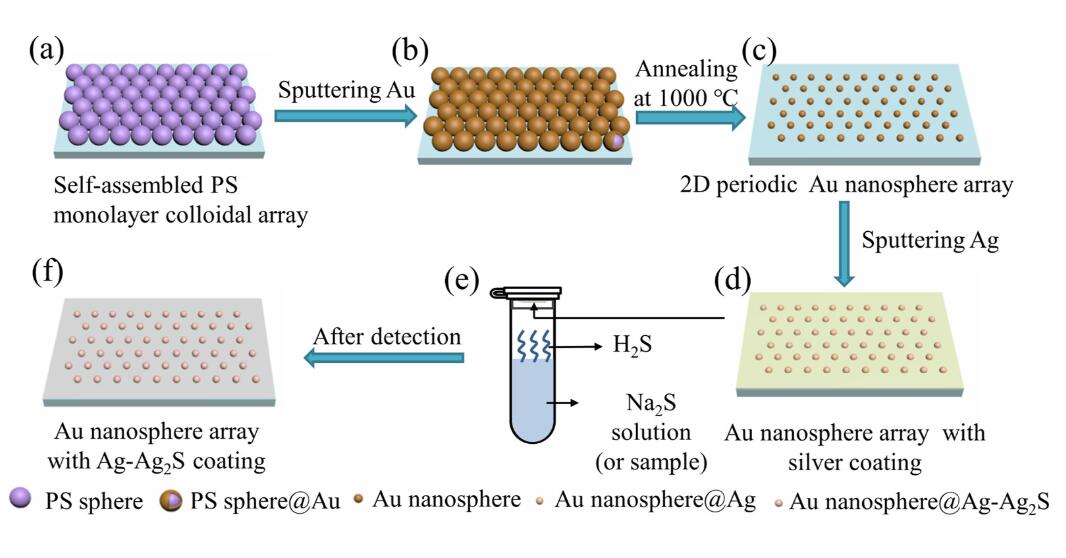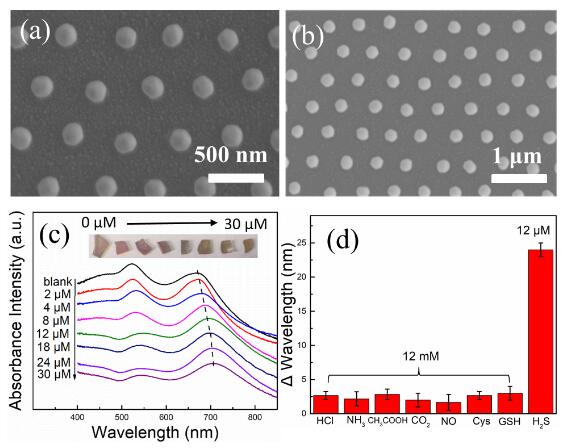
A new study revealed that the synthesized periodic Au nanoparticle array with silver coating showed highly selective and sensitive detection of hydrogen sulfide (H2S), which described a new strategy for effective H2S sensor without direct contact.
This study was conducted by a research team led by Prof. LI Yue from the Institute of Solid State Physics, Hefei Institutes of Physical Science.
Noble metal (Au, Ag, etc.) nanoparticles (NPs) appeared as surface plasmonic resonance (SPR) absorption peaks in their absorption spectra. The NPs can be used as localized surface plasmonic resonance sensors in the field of biochemical sensing. But it usually requires a complicated post-modification process to enhance the interaction between the probe molecule and the NPs, and the sensitivity is low due to the small SPR peak shift.
While in this case, for two-dimensional (2D) periodic noble metal arrays, the diffraction peak is very sensitive to the refractive index of the surrounding environment. Therefore, the periodic noble metal array can be used as a new sensor utilizing the diffraction peak.
In this work, 2D periodic Au nanoparticle arrays with silver coating were prepared by colloidal templates and further by magnetron sputtering deposition of silver. The diffraction peak of the Au nanosphere array with silver coating showed a sensitive red-shift with increasing of H2S concentration.
With the good linear relationship between the wavelength of the diffraction peak and the low concentration of H2S, the Au nanosphere array with silver coating exhibited excellent selectivity to the detection of H2S due to the specificity of the reaction between silver and H2S. Therefore, effective H2S sensor is possible by monitoring the change of optical diffraction peak of periodic array.
In addition, this method was well demonstrated by the H2S analysis in H2S-spiked blood plasma samples, which is helpful to detect H2S in blood.
This investigation was supported by the National Science Fund for Distinguished Young Scholars, the Natural Science Foundation of China, the National Key Research and Development Program of China.

Figure 1. Schematic diagram of fabrication of Au nanosphere arrays with silver coating and their H2S detection. (a)-(d) the fabrication of Au nanosphere arrays with silver coating; (e)-(f) the H2S detection. (Image by LI Xuejiao)

Figure 2. (a) High- and (b) low-magnification FESEM images of the obtained Au nanosphere arrays with silver coating. (c) Extinction spectra of the Au nanosphere arrays with silver coating under different concentrations of H2S for 20 min at 40 ℃, pH=7 and photographs of the color changes of the Au nanosphere array with silver coating (inset); (d) Variation plot of the wavelength of the diffraction peak against concentration of H2S. The inset is a fitting plot in the linear range. (Image by LI Xuejiao)

86-10-68597521 (day)
86-10-68597289 (night)

52 Sanlihe Rd., Xicheng District,
Beijing, China (100864)

